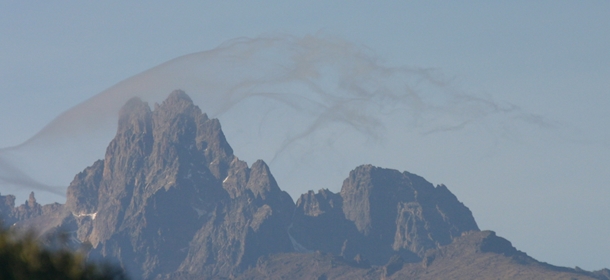 The two biggest mountains in East Africa are Mount Kenya and Mount Kilimanjaro and both are well worth a visit. We thought we would take a look at both of them side by side and see how these titans measure up against each other.
The two biggest mountains in East Africa are Mount Kenya and Mount Kilimanjaro and both are well worth a visit. We thought we would take a look at both of them side by side and see how these titans measure up against each other.
Mount Kilimanjaro is Africa’s tallest mountain and can be found in northern Tanzania near the town of Moshi and about an hour’s transfer time from Arusha airport. It is also the tallest free standing mountain in the world as it rises from the flatlands to 5,895 metres ( just under 20,000 feet). Kili also happens to be a relatively accessible high peak and attracts visitors and climbers from all over the world. Conquering its snowy peak is on many people’s things-to-do before you turn 50 lists!
Many teams do the hike to raise money for charity and it is tougher than you might expect. The main routes up Kili are the Machame Route, the Rongai Route and the lesser used Lemosho Route although there are 3 other routes as well. Most trips take between 10 and 14 days and must be arranged through a local company as you will need permits, porters and a back up team to successfully climb the peak. Climbers can reach the crater rim with little more than a walking stick, proper clothing and determination. Those who aim a little higher for Uhuru Point, the actual summit, or Gillman’s Point on the lip of the crater, they have a tougher climb ahead.
Even the lower slopes are massively diverse and as you climb you ascend through a virtual climatic world tour, from the tropics to the Arctic. Even before you cross the national park boundary, the farmland at the foot give way to green mountain forest, inhabited by elephant, leopard, buffalo, and other small antelope and primates. Higher up you reach the moorland zone, where a cover of giant heather is studded with otherworldly giant lobelias. Then at around 4,000m, a surreal alpine desert supports little life other than a few hardy mosses and lichen. And finally, the last vestigial vegetation gives way to a winter wonderland of ice and snow – and the magnificent beauty of the roof of the continent. The best time to go is when the weather is at its warmest and clearest so that the views are impressive and the conditions not too hazardous as you will be camping in makeshift huts and tents up on the mountain. This is usually from December through to February although some people also go from July to September when it is colder but still dry with good visibility.
Mount Kenya as its name implies lies in neighbouring Kenya and is only slightly lower than Kili. It is the second highest in Africa with a summit at 5,199 metres. The highest peaks of the mountain are Batian, Nelion and Point Lenana. These are clearly visible giving its outline a serrated look. It is about 100 miles north of Nairobi and as such relatively easy to reach. Most of it is protected national park and also a UNESCO World Heritage Site. It is actually an extinct volcano as most of the mountains along the Great Rift Valley are and it, like Kili, has an amazing amount of diverse vegetation and wildlife as you rise up its slopes and through different climatic zones. The whole area is protected also as an area of outstanding natural beauty and the scenery is simply stunning. There are also several amazing glaciers although they appear to be retreating at a worrying rate.
Point Lenana can be reached by walking but all the other peaks require proper mountain or rock climbing to reach them. Up to 15,000 people a year visit this peak but only a couple of hundred climb Nelion and only a handful manage Batian. There are eight walking routes up to the main peaks. Starting clockwise from the north these are the: Meru, Chogoria, Kamweti, Naro Moru, Burguret, Sirimon and Timau Routes. Of these Chogoria, Naro Moru and Sirimon are used most frequently and therefore have staffed gates. The other routes require special permission from the Kenya Wildlife Service to use. The Naro Moru route is taken by many of the trekkers who try to reach Point Lenana. It can be ascended in only 3 days and has bunkhouses at each camp. Another popular option is the Peak Circuit Path is a path around the main peaks, with a distance of about 10 kms and climbing over 2,000 m both up and down en route. It can be walked in one day, but more commonly takes two or three.
Mount Kilimanjaro has the kudos of being Africa’s highest peak but Mount Kenya has just as much to offer as Kili if not more including fabulous scenery and amazing climbing on offer to those who have a head for heights.